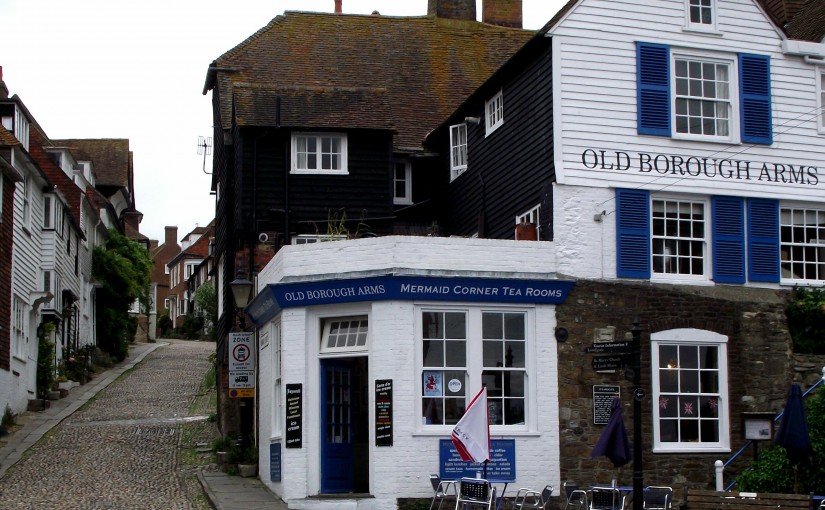By David Russell
Little early history of the Borough Arms has come to light. What is known is that by the end of the 16th century it was known by the sign of the ‘Blue’ or ‘Blew Anchor’.
The earliest reference to the Blew Anchor is 1592 when it was kept by a carpenter called John Hammond. A century later it was a well established licensed premises, and by 1728 it had become the London Trader, named after a type of coastal vessel then plying between the south coast ports and London. It was then Corporation property rented to Joseph Tucker at £3. 5s [£3.25] per annum.
In the 18th century the London Trader was an auction house for new and used boats. In 1803 for example, a smack called the ‘William and Anne’ ‘in the Boulogne trade’ was auctioned here and a sloop called ‘Industrious’ ‘in the chalking trade’ was also auctioned off.
A noted landlord was James Shearer (1838–1840). Many years after his time as landlord, the following edited article, appeared in the South Eastern Advertiser in 1875.
A BIT FROM LOCAL HISTORY
A centenarian died at Hamilton, near Glasgow, about a week since, a widow woman named Paterson, at the remarkable age of 105. She was a person of great vigour of intellect, and retained possession of all her faculties till within a few months of her death. Her descendants consist of 10 children, over 100 grand children 60 great grand children, and 2 great great grand children. In recording the above in our notice we must observe that the deceased old lady’s maiden name was Shearer, and many of our readers in Tenterden, and a very great many more in Rye, will be able to call to mind a Mr James Shearer, a tailor, and father of Mrs Skinner Ranger of Tenterden, who died in this town about thirteen years ago, at the age of 87. The old lady above referred to was sister to Mr James Shearer. No doubt some old people of Rye will remember, after reading this notice, a rather wonderful episode in Mr James Shearer’s life. We allude to the cutting of the new sluice, which took place about fifty years ago.
Now it appears this somewhat interfered with the operations of the smuggling fraternity, who, with the assistance of a considerable mob of roughs and rioters, thought they could prevent the work from being carried out. A man of war had been sent down to Rye to protect the works, with orders to fire on the rioters should they persist in their unlawful measures. A large body of these misguided people, fully armed, were assembled in the back premises of the London Trader, at that time kept by Mr Shearer. As the time drew on, a conflict between the man of war’s men and the rioters seemed inevitable. Mr Shearer addressed the latter from the ‘Iron Bridge’, pointing out the folly of their resistance to lawful authority, as also the likelihood of a great loss of life, and so prevailed on the men that they refrained from all further show of force. In connection with these events, Mr Shearer afterwards was one of the principal witnesses at the Assizes held at Kingston-on-Thames.—N.B.—Should any person in Rye be able to throw any further light on the affair, will he be kind enough to communicate to the editor.
The editor’s appeal elicited the following letter:
Sir,—In the article ‘A Bit from Local History’, in your last week’s issue, you invite communications on the subject. I knew the late Mr Jemes Shearer well.
The episode in his life, there mentioned, cannot exactly be deemed ‘Truth severe, by fairy fiction drest’, although there is an amount of fiction in the account which mars the story. I do not remember at what date Mr Shearer kept the London Trader Inn; but that he was landlord of that hostelry then patronised by mariners. I can testify, and that the opponents of the New Scots-float Sluice, then in course of erection, might assemble in his back premises, I will not pretend to dispute, but that he did not address them from the ‘Iron Bridge’, as recorded, is obvious, because (as the comic song says) ‘It wasn’t built till after that’; it having been erected about 25 years, and the sluice nearer 50 years. Neither do I believe that smuggling had anything to do with the matter. About that time there was a ‘Free Navigation Society’ established in the town, composed of very respectable individuals, and their meetings were held in the long back room of the London Trader. The neighbouring land owners and the members of this society were at issue, the former desiring a sluice to protect their land from inundation, and the latter anxious to secure a free course for the tidal waters as far inland as they would go, that at the ebb they might rush out and scour the harbour. The late Herbert Barrett Curteis, Esq., MP for East Sussex, as a land owner, engaged a few men-of-warsmen, stationed here to prevent smuggling, to protect the sluice from threatened injury, but no man-of-war was ever stationed here for protection to the sluice. These remarks, entirely from memory, may elicit further information from some person better acquainted with the subject than myself.
I am, sir, respectfully yours
HENRY HEASMAN 1875
As one of the town’s older inns the Borough Arms had more than its share of benefit societies. The Wellington Lodge of Freemasons was formed here in 1814. The Ancient Towns’ Benefit Society, established here in 1828, was twice dissolved; the funds shared out, and then reformed. The society at that time had about 135 members, but by the 1860s it had transferred to the Cinque Ports Arms.
The Prince of Wales Odd Fellows was started here in 1842 with 115 members but later transferred to the Red Lion. The Foresters Harold Lodge was started here in 1855, also with 115 members, and also later transferred to the Red Lion.
The Unity Benefit Society was established here in 1859 with 35 members which by 1864 had increased to 80. They were still meeting here in 1881 when Unity Goose Raffles were a popular attraction. All of these clubs and societies, along with the ‘opponents of the Scotts Float Sluice’, used the ‘long back’ room on the first floor with an entrance in Trader’s Passage. Other bars on the first floor included a ‘sots hole’—a small curtained-off section for privacy. The corner building, now the Mermaid Corner Tea Rooms, was originally the tap room and later the public bar.
In the Great Depression of the 1890s beer consumption started to fall and the pub struggled to keep its custom. In 1893 the landlord, considering ways to improve his business, started selling greengroceries in the tap room, bringing complaints from the police. When he did this on a Sunday morning he was cautioned for trading ‘during the hours of divine service’, and obliged to stop.
His next innovation, in 1897, was to change the name from the London Trader to the Borough Arms. The brewers followed in 1901 with alterations and improvements. But after 300 years the pub never regained its former vitality. Between 1900 and 1906 the Borough Arms had several landlords. One of them, stayed less than a year. None of the other six stayed more than a few months and the Borough Arms gradually fell out of favour.
Thus, in 1906 the police easily claimed that the pub was redundant and ‘no longer required’. The magistrate pointed out that the Ship ‘a superior house was only 40 yards away.
A letter to the local paper commented that:
There is only one public house which I would have voted for closing, and I have nothing to say against the brewer, the tenant, or the way in which the house is at present conducted. But I think of days gone by, when its victims have come out into the night air, and having been overcome, have stumbled to their doom.
The writer was referring to the long flight of stone steps outside the pub.
In 1907 the Borough Arms was included in a property auction at the George, but the bidding reached only £190 and it was withdrawn. The property then lapsed into a neglected state and the former public bar became a Customs Office.
With the onset of the depression in the 1920s, the Customs Office became a Ministry of Labour Office attempting to find jobs on the quay and riverside.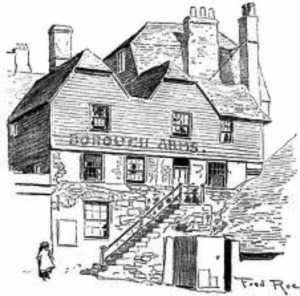
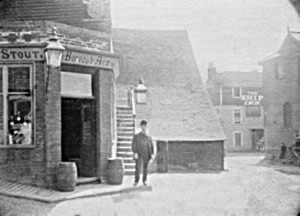
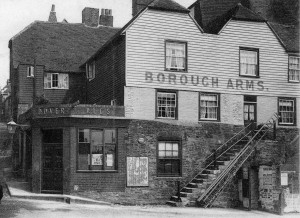
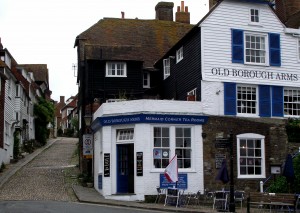
Other pub histories can be found in the book The Pubs of Rye, East Sussex 1750–1950 by David Russell. The book, illustrated with around 100 photographs, is in paperback, 282 pages, priced £13.99. It is available at Martello Bookshop, Adams of Rye, Rye Tourism Information Centre, Rye Heritage Centre and Waterstones in Hastings. It is also available at www.hastingspubhistory.com, by email: [email protected] or phone 01424 200227.
Don’t forget Father’s day June 16th. This book makes an ideal present.
“Rye’s Own” Jun 2013 Issue
All articles, photographs and drawings on this web site are World Copyright Protected. No reproduction for publication without prior arrangement. © World Copyright 2015 Cinque Ports Magazines Rye Ltd., Guinea Hall Lodge Sellindge TN25 6EG
